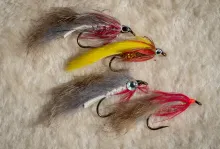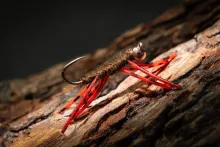Inspired by Kim Sorensen's salmon fly the Munker I set out to make a sea trout variant for the salt
Kim Sorensen and Frank Thornild's Munker fly has been a great success on Danish salmon rivers and is a fly right after my heart. Not only is it a Muddler, but it's also a a Zonker - hence the name Munker.
The fly is an obvious fly
to adapt for sea trout in the salt with its short and plumb shape, nicely imitating the different species of goby that are high on the menu for sea trout, particularly in the spring where small specimens gather in the shallow water, which warms up quickly.
Tied in gray and brown
shades the Munker looks very much like these small, short and chubby, bottom dwelling fish. The shape and the weight makes the Munker and obvious contender for the role as a goby imitation.
So I tied up some
in natural colors and omitted the Jungle Cock and wound up with some excellent small and medium light flies, well suited to be cast on a 5, 6 or 7 weight and definitely something that I'm going to serve to the silver bars of the Baltic as soon as possible.
Since the fly has worked wonders on salmon in the rivers, I see no reason to doubt that it can also entice a sea run brown.
The materials list
and tying sequence is the same as on Kim's salmon version, but just without the Jungle Cock, which I find a little overkill for saltwater flies, even though I know that some tyers like these exotic (and expensive) feathers on their imitations. I haven't tied any flash into the flies either. Gobies are quite dull and well camouflaged, and don't make much fuss of themselves, so no reason to add further attractions. The rubber legs I like, and they will add fin-like movement to the flies.
|
|
|
|
|
|
|
|
|
|
|
|
|
|
|
|
|
|
|
|
|
|
|
|
Mounting and fishing the fly
As with other tube flies, you mount the hook after the fly has been tied. Select a piece of of junction tube and a suitable hook - single, double or treble - and pass the tippet through the fly from the front, through the junction tube and then tie it onto the hook using whatever knot you prefer. Trim the tag of the tippet and pull the hook shank into the junction tube and taught against the rear of the fly. You are ready to fish. The gobies are bottom dwelling fish, and this fly will willingly sink to the bottom of shallow water and can be fished slowly over the bottom.
- Log in to post comments































